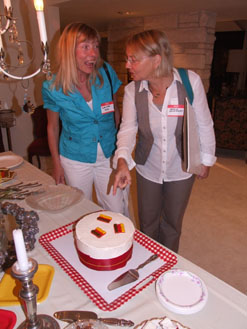
By Donald H. Harrison

SAN DIEGO — Bobby Greene doesn’t like to take credit. She typically defers to her husband Norman Greene, who is the current president of the Louis Rose Society for the Preservation of Jewish History. Sometimes, she even tries to say my biography of Louis Rose was responsible . But we all know better.While it was a team effort, Bobby is the one that deserves the most kavod for getting a German language program started at Cabrillo Elementary School, a program that recently was awarded a three-year grant from the U.S. Defense Department of $80,000 per year.
How did she get the ball rolling? And how does an organization focusing on local Jewish history get involved in a German language program at a local elementary school?
Well, Louis Rose was born in the river port of Neuhaus an der Oste, Germany, and nearly immediately after becoming the first Jewish settler in San Diego in 1850, he decided that the city’s commercial center ought to be relocated from its Old Town location to the shore of San Diego Bay so it could take advantage of shipping the way that Neuhaus does.
Cabrillo Elementary School serves Roseville, the bayside neighborhood in San Diego that Rose created in 1869. In fact, six years after Rose died, his daughter Henrietta was appointed in 1894 as the first teacher at Cabrillo’s forerunner school, Roseville Elementary School.
With those facts as background, the Louis Rose Society suggested to Nestor Suarez, the principal of Cabrillo Elementary School, that he consider entering into a sister-school relationship with the elementary school, called a grundschule, in Neuhaus an der Oste. Letters were sent to Doris Henningson, the Neuhaus principal, and before long the two schools decided to partner.
For 38 years, Bobby Greene had been a French language teacher at Montgomery High School near San Diego’s border with Mexico. She knew that for an exchange program to work, the pupils at Cabrillo would have to speak and read some German. Although students in Neuhaus learn English, it wouldn’t be fair to put all the burden for the exchange on them.
So, Bobby went around to some of the universities in town, including Point Loma Nazarene, San Diego State, and UCSD, but where she really hit pay dirt was at the University of San Diego. She recruited five students in the German language class of Christiane Staninger, an adjunct assistant professor of languages and literatures, to come to Cabrillo over the last term and teach the children in kindergarten and first grade German greetings, colors, numbers, and some songs. Thanks to those students — Janet Easler, Caroline Kerschner, Alyssa Ong, Jan Rogers and Chris Voets – the program has expanded to the third grade.
Meanwhile, alluding to the “German culture” being taught at the school, Bridget de la Garza and J.D. Dyas applied to the U.S. Department of Defense for a grant. Their San Diego Unified School District department deals with “children and youth in transition” –a classification that includes school-age dependents of Navy and Marine Corps personnel in San Diego, who get transferred from military base to military base.
They persuaded the DOD that grants would be helpful in financing the German language program at Cabrillo as well as a Mandarin language program at Dewey Elementary School, two languages that may be of use in dealing with other military forces in the world. Its criteria met, DOD came through with money for both schools.
Had it not been for Bobby Greene, there would have been no “German culture” for de la Garza and Dyas to point to — but because of her efforts, as well as those of Cabrillo’s principal Nestor Suarez and language program coordinator, Skye Oluwa, a program had been fashioned in which the student volunteers had pedagogical supervision.
Now with the $80,000 per year, Cabrillo will be adding three personnel to its staff — a half-time credentialed German language teacher, and two interns from Germany who will be brought here through the Amity program to serve as assistant teachers. Under the program, the interns will enjoy home hospitality from members of the Cabrillo community.

Meanwhile, principal Henningson and teacher Dorothee Fetz from the Grundschule of Neuhaus arrived in San Diego on two week-long visit to map sister school programming with Cabrillo principal Suarez and language coordinator Oluwa. While here, they toured San Diego, attended educational training sessions, taught Cabrillo pupils, were honored with a reception at the Greene’s home and were guests at a Shabbat dinner at the home of Eileen Wingard. At the end of the spring semester, Cabrillo Elementary School will send at least one of its faculty to Neuhaus an der Oste on an exchange visit.
Henningson brought invitations from the children of Neuhaus to the children of Cabrillo Elementary School to become their pen pals. She also brought picture books and videos so that the children of the town site that Louis Rose built could see the town where he was born.
Independently of each other, both schools had chosen sailing ships for their emblems, an indication of one of their commonalities.
Another is Louis Rose himself, as he is the link between the two schools. As students learn more about him, and perhaps research portions of his life on two continents, the teamwork and friendships they develop in so doing will be another of Rose’s legacies.
And it will be part of Bobby Greene’s legacy as well.
*
Harrison is editor of San Diego Jewish World. He may be contacted at donald.harrison@sdjewishworld.com